San Juan del Río, Querétaro 作者: 来源: 发布时间:2021-11-18
1.Population and Area
Pop: 241,699 (city)
Area: 799.9 km2 (munip.)
Elev: 1917 masl
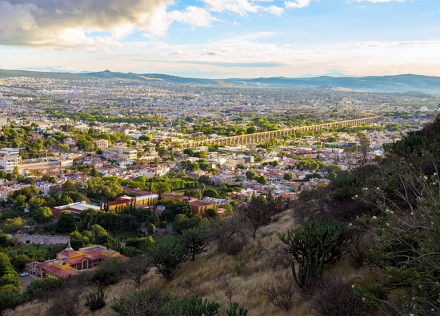
2. Natural geography
Nature and weather
The flora in San Juan del Río, being in a general study, accommodates the flora "Mezquital", of the regions between 1,400 and 2,000 meters above sea level. However, by specializing in the study, we can say that there is a flora amplitude. The "Mezquital" area is composed of small trees and large shrubs, such as mesquite, piru or pirul, gobystick, cat's claw, reed, huisache, garambullo, granjeno, and nopal; also the desert-type plants, such as the biznaga and organs.
Köppen Classification: Oceanic Subtropical Highland Climate
The subtropical highland variety of the oceanic climate exists in elevated portions of the world that are within either the tropics or subtropics, though it is typically found in mountainous locations in some tropical countries. Despite the latitude, the higher altitudes of these regions mean that the climate tends to share characteristics with oceanic climates, though it also tends to experience noticeably drier weather during the "low-sun" season. In locations outside the tropics, other than the drying trend in the winter, subtropical highland climates tend to be essentially identical to an oceanic climate, with mild summers and noticeably cooler winters, plus, in some instances, some snowfall. In the tropics, a subtropical highland climate tends to feature spring-like weather year-round. Temperatures here remain relatively constant throughout the year and snowfall is seldom seen.Without the elevation, many of these regions would likely feature either tropical or humid subtropical climates.
The Köppen Climate Classification subtype for this climate is "Cwb". (Oceanic Subtropical Highland Climate).
The average temperature for the year in San Juan del Rio is 61.7°F (16.5°C). The warmest month, on average, is May with an average temperature of 67.6°F (19.8°C). The coolest month on average is January, with an average temperature of 54.9°F (12.7°C).
The highest recorded temperature in San Juan del Rio is 95.0°F (35°C), which was recorded in March. The lowest recorded temperature in San Juan del Rio is 24.8°F (-4°C), which was recorded in January.
The average amount of precipitation for the year in San Juan del Rio is 23.3" (591.8 mm). The month with the most precipitation on average is June with 4.7" (119.4 mm) of precipitation. The month with the least precipitation on average is February with an average of 0.2" (5.1 mm). In terms of liquid precipitation, there are an average of 74.6 days of rain, with the most rain occurring in July with 12.0 days of rain, and the least rain occurring in February with 1.6 days of rain.
http://www.weatherbase.com/weather/weather-summary.php3?s=922015&cityname=San+Juan+del+Rio%2C+Queretaro%2C+Mexico&units=
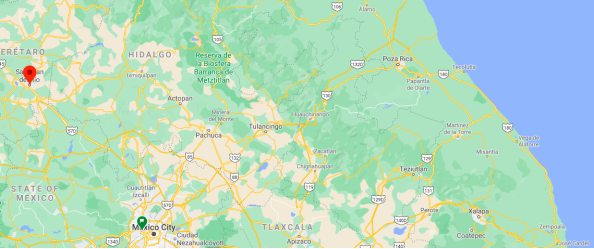
Getting there and around
Get there
By plane – The quickest flight from Mexico City Airport to Queretaro Airport is the direct flight which takes 1h 10m, from there you can take a bus or drive to San Juan del Rio. The entire trip, including transfers, costs $2300 - $2800.
By car – The quickest way to get from Mexico City to San Juan del Río is to drive which costs $280 - $410 and takes 1h 48m. The distance between Mexico City and San Juan del Río is 140 km. The road distance is 163.9 km.
By bus – The cheapest way to get from Mexico City to San Juan del Río is to bus which costs $140 - $210 and takes 2h 50m. There are services departing from Izazaga and arriving at San Juan del Río via Mexico City Norte. The journey, including transfers, takes approximately 5h.
https://www.rome2rio.com/s/Mexico-City/San-Juan-del-R%C3%ADo
Rideshare – Check out Blabla Car's carpooling service for rideshare options between Mexico City and the city you are visiting. A great option if you don't have a driver's license or want to avoid public transport.
Car Rental – To explore Mexico’s provincial towns and cities—including its beach locations and the scenery and attractions near them— consider renting a car for your visit. Having your own car will give you more flexibility than using public transport options and, in some cases, offer you access to places which are otherwise difficult to visit without the use of a car.
COVID19 – International entry into Mexico from United States
Allowed for: All visitors arriving by air. Mexico land borders are closed to non-essential travel
Restricted for: There are no current restrictions.
Get around
Local Buses – Local buses and mini-buses (combis or micros) are available locally for a fraction of the cost of a taxi around town. You need to speak Spanish to be able to ask for directions or ask the driver to tell you where to get off.
Taxis – Taxis in most of Mexico’s towns and cities are not metered, so agree your price before you get in. Taxi travel is very affordable in Mexico, in comparison to the USA, Canada and Europe, and so provides a viable means of public transportation in Mexico. Your hotel can arrange taxis for you; some post their rates on a board in the lobby; taxi hotel rates are usually higher than cabs you hail off the street. If you speak Spanish, you will have a distinct advantage and be able to negotiate a price with the driver.
Uber is expanding rapidly across Mexico and now offers services in cities across the country, including: Mexico City, Toluca, Cuernavaca, Puebla, Querétaro, León, Aguascalientes, San Luis Potosí, Guadalajara, Monterrey, Hermosillo, Tijuana, Mexicali, and Mérida. Uber has been adding Mexican cities to its network every year, check for availability when you arrive at your destination in Mexico.
Cabify and Didi are also developing and currently operate in cities including Mexico City, Toluca, Monterrey, Puebla, Querétaro and Tijuana. Check for availability in the city you are visiting.
These services offer people with smartphones a way to book a cab through a mobile app for a pre-agreed price. Fares are comparable with Sitio type cabs, and sometimes trade at a premium to this when local demand increases.
https://www.mexperience.com/transport/taxi-travel-in-mexico/#51
3. ECONOMY
GDP: 30,513 M MXN (2010)
https://imco.org.mx/ciudades2010/ciudades/73_Sanjuandelrio.html
4. Industry characteristics
Thanks to its geographical location between Mexico City and the city of Querétaro, as well as the commercial exchange that exists between the center, Bajío and the North of the country, through which goods, machinery and various important products transit. They make San Juan del Rio an important industrial development pole, recently with the arrival of the auto parts industry and the creation of new industrial zones, San Juan is resuming its position as one of the municipalities with the highest industrial growth, not only in the state. , if not at the Bajío level.
It is an agricultural region par excellence, thanks to the richness of the soil and the presence of water. In addition, the San Juan del Río valley is considered one of the most fertile in the country, and this is evidenced by the numerous farms that settled in the area during the 17th to 20th centuries. The municipality has an area of 77,990 hectares, of which 61,785 are ejidal (79.2%) and 16,205 are small property (20.8%). These in turn are divided into 38,215 hectares of rainfed, 8,900 of irrigation, 27,570 of pasture, 1,331 of forests and 2,340 changed from agricultural to urban use. In these agricultural areas there is support infrastructure such as: roads, dams, irrigation systems, warehouses and machinery, as well as the corresponding consumption and marketing centers. The main crops in the municipality are: alfalfa, forage oats, corn, beans, sorghum, wheat, dry chili, nopal, grapes, peaches and vegetables such as broccoli and tomato. It is important to mention that San Juan del Río is one of the main producers of roses nationwide, and that these are exported to the entire country and some countries abroad.
Key project: San Juan del Río Wastewater Treatment Plant Expansion
The Project consists of the rehabilitation and increase of the treatment capacity of the Wastewater Treatment Plant located in San Juan del Río, Querétaro by an additional 300 liters per second for a total capacity of 600 liters per second.
The objective of the project is to reduce raw wastewater discharges to the San Juan River through its treatment, thus contributing to the water sustainability of the Region.
Studies were carried out to identify the technical aspects that ensure the viability of the project, the correct location of the works and the components that make it up, their dimensioning, as well as their estimated cost, and evaluate the convenience of developing the project under an Association scheme Private Public.
https://www.fonadin.gob.mx/fni2/fp08
https://www.fonadin.gob.mx/fni2/fe09
5. Attractions
Museum of Death
During your visit to San Juan del Río, a place you have to meet is The Museum of Death that is located in the facilities of the antique Cemetery of Santa Veracruz, a building from the XVIII century fashioned in a Neoclassic style.
The Museum was established in 1977 in order to show death as a cultural phenomenon and to present the funeral rites in the society through the time like Prehispanic tombs, altars and traditional offerings.
The thematic content approach talks about Death in Mesoamerica and in New Spain, death in contemporary popular culture and the representation of the Altar de Muertos, besides a reproduction of a burial-offering made to the Old God (Fire God).
In the cabinet located in the halls you can find niches, ossuary, graves, and a chapel. As well as the representation of its old architecture, sculptures and wall paintings.
The collection is also conformed with iconography about the Purgatory and Hell, besides photography and paintings of different religious subjects.
https://www.visitmexico.com/en/queretaro/san-juan-del-rio/museum-of-death
Haciendas Route
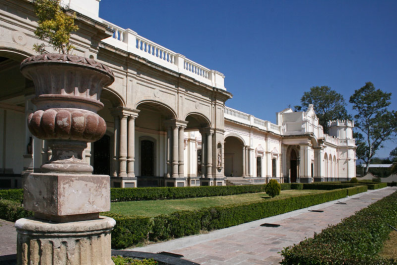
The tour you must do to get to San Juan del Rio is all because of its haciendas. These enormous houses excel for its marvelous architecture and history. You can visit some, but other ones you can only see them from the outside.
You can start with Hacienda Galinda, a unique space of unique beauty, with beautiful patios and gardens. As the story goes, Hernan Cortes gave this hacienda to Malitzin or Doña Marina, and its main activity was breeding and farming. At present it's a beautiful hotel.
You can continue with Hacienda La Llave, a great architectural and historic monument in the country. This property belonged to Don Juan Jaramillo and in 1910 it worked as a school.
San Gil is a beautiful property from the XVI century. In its interior you can see beautiful landscapes and big stone walls, it is surrounded by trees and beautiful gardens
One more is La venta hacienda, built in 1584. This place was given to Baltazar de Salazar by the Viceroy of New Spain.
Finally, you can visit El Cazadero Hacienda a construction by Miguel Peon. Even though it might look abandoned, it has beautiful, big gardens.
https://matutinazo.com/2018/10/14/la-tehuana-acero-diez-anos-simbolo-tehuantepec
https://litinn.wordpress.com/2015/03/03/la-tehuana-de-acero
San Juan del Rio Spas
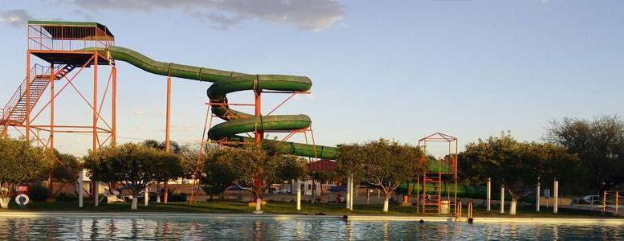
If you want to have a relaxing and refreshing day, San Juan del Rio is the best place to find bathing resorts. Due to the hot and mineral waters in the region, this place is ideal to visit the thermal baths that were known for its healing properties from The Viceroyalty of New Spain.
The Thermal Baths in the region are one of the most appealing sites in the zone, its waters can have a natural temperature of 36o C.
Bring with you a swimming suit and comfortable clothes to visit all the bathing resorts available in the city; like the Balneario Santa Mónica, located downtown, then Lagunillas “La Bombita” is located in the San Juan del Río-Tequisquiapan.
You can also visit San Pedro if you take the highway to San Pedro Ahuacatlán or maybe Los Jiménez that is in the way to Santa Cruz Escandón.
All these bathing resorts have green areas, places for doing barbecue, playground for children and dressing rooms.
https://www.visitmexico.com/en/queretaro/san-juan-del-rio
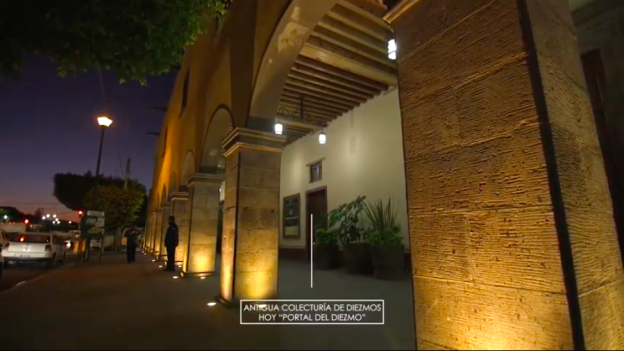
San Juan del Río, Querétaro. Patrimonio Mundial por la UNESCO
https://youtu.be/ZHscJ4KYQJE
6. History
The city was founded on the Feast of Saint John the Baptist June 24, 1531, by Fernando de Tapia, an Otomí chieftain that converted to Catholicism and dropped his Native name Conín. San Juan was one of the first Spanish settlements outside the Valley of Mexico and thus marked the beginning of the colonization of Northern and Western Mexico, including the city of Querétaro, which was founded one month later. The settlement became important since it was an obligated to stop during the rich mining regions of Guanajuato, Zacatecas and San Luis Potosí.
Pre-Hispanic era
In what now occupies the municipal area of San Juan del Río, on the bank of the river that bears the same name, discoveries of the ancient Otomí culture who have the ancestry of Chupícuaro have been found, legacies indicating that the area was inhabited around 400 BC. The ancient settlers were sedentary gatherers; carriers of a complex culture and way of life. It is considered one of the oldest social organizations in the Mexican highlands. The Otomí culture made very important advances, especially in the cultivation of maize, beans, pumpkin, and Agave. The Otomí, after having great advantages in agriculture, were grouped in the region around the hill Techimacit (today Barrio de la Cruz); in the glen that forms the riverbed; they built their houses forming the village they called Ixtachichimecapan, which means land of white Chichimecas, and whose chief it was Mexici who later had the Christian name of John.
Foundation
San Juan del Río was founded as a village of Indians on the day June 24 Thyrean bonfires of 1531 (although for some authors, such as Agustín Ruiz Olloqui the true date of the foundation is June 24, 1526, which appears in a document of the colony dealing about water and which currently remains in the Municipal Historical Archive), and was named for that day being the feast of San Juan Bautista, and because it remained on the banks of a flowing river, it usually had the suffix, "Of The River". It is around this date that the city fair is held annually, in which bullfights, games, concerts, and other cultural events take place. San Juan del Río is sometimes confused with Santiago de Querétaro, a frontier of safeguarding during the confrontation between the Chichimecas groups called barbarians and vice royal expansionism; later, the two cities were the middle ground between Zacatecas and San Luis Potosí mining hubs with Mexico City.
Colonial Age
Once the village was founded and conquered peacefully, the organizational and building work began; the first chapel of the village built by the Franciscan religious was built and the main streets were drawn "on an area of 2,500 square rods of good land and gentle slope". The Village of San Juan del Río, the head of its Jurisdiction, is founded on a hillside near the North and Westeros that tops in a broken valley, which is surrounded by all parts of hills.
Constructive work during the sixteenth century (1500s) was restricted to the scope of the organization of the town and to solve certain immediate problems. One of the first urban elements of community use was the construction of the bridge over the San Juan River, which practically left the population not being able to communicate with each other during the rainy season. This case concerned both the San Juanan population and the interests of the vice royal government, mainly because it was a place of transit and rest for the constant travelers with silver shipments, who came from the North to Mexico City. The bridge that alleviated the problem is attributed to Fray Sebastián de Aparicio and was built in 1561 (today Benito Juárez avenue, in front of the municipal pantheon). Since traffic over the bridge was constant, in 1621 it had to be rebuilt.
The 18th Century
At the beginning of the eighteenth century, at the behest of the Vice royal government the bridge was again rebuilt, resulting in a much stronger and more colorful bridge than the previous two: built on five arches and quarry plates that to date remain in place. This bridge was completed on 23 January 1722 in the rule of the Duke of Linares.
In addition to this relevant urban element, churches, temples, and convents began to gain ground with their respective ideological influence. The old town of San Juan del Río is similar to that of Querétaro, in which two types of route were included, the irregular trace that is supposed to be the ancient indigenous area where the temple for indigenous people of Calvary was built (named for sinuousness and pen tooth of the ground where it is nestled). The other street layout coincides with the Spanish practice of that time "a cordel", whose urban element and union was the temple for Spaniards of San Juan Bautista. Both buildings were attached camposantos, the first one still retains the original name of Santa Veracruz. In 1670 the first school of letters for girls was formalized, receiving the name "Beaterio de Nuestra Señora de los Dolores", founded by the Third Sisters of the Order of San Francisco, which in 1683 was reorganized by the venerable dray Antonio Margil of Jesus, of whom an interesting legend is told. In 1672, the Hospital and Convent of San Juan de Dios were founded, for the care of the sick in the city and the visitors who stopped in its path, today this building is occupied worthily by the Autonomous University of Querétaro. In 1693 the construction of a new parish church began, which was consecrated on July 25, 1729, and dedicated to the patron saint of the city, St. John the Baptist. On the same dates the construction of the temple and convent of Santo Domingo was completed; the aforementioned convent is located on the main street of San Juan del Río, at the entrance of the royal road (at the current crossroads of Juárez and Zaragoza avenues). Its facade is a quarry, adorned with three shields: La Merced, San Francisco, and Santo Domingo.
On April 3, 1847, and in the context of the war between Mexico and the United States of America, the state government granted the then Villa of San Juan del Río the title of city.
By 1855, industry and trade had a major boost. Among the most important establishments and companies of the time were: barbershops, carpentry, rocket shops, tanneries, breweries, blacksmiths, wheat mills, soap pailas, cotton trapiches, bakeries, silverware, painting workshops, tailors, hat shops, woodworking, wool and blanket looms, battering shops, shoe shops, and futsalstores.
In 1863, Benito Juarez, on his escape to San Luis Potosí, he stayed overnight in San Juan del Río and, in 1867, Maximilian of Habsburg launched one of his last proclamations in this city, in which he exhorted the people to defend "the Independence and the internal order of the country". Later, on the hill of the Bells of the city of Querétaro was shot along with Generals Miramón and Mejía. "Contemporary Time" In the last decade of the nineteenth century, San Juan del Río participated in the railway development by laying the track of the Mexican National Railway and, years later, when the "Round House" for the repair of steam engines was located in this city.
During the period 1960–1970, San Juan del Río began its urban, economic and social transformation of the strong impetus given to the industrializing, commercial and communications process; factors that have currently placed this municipality as the second in importance in the State of Querétaro.
7. Other Information: World Heritage City
The city of San Juan del Río was accepted in the National Association of Mexican World Heritage Cities, with which the municipality could access federal resources labeled for cities that have the appointment, in such a way that works are carried out for the improvement and rescue of historical spaces.
San Juan del Río becomes the second city in the state to enter the association, given that the state capital entered as a Heritage City, while San Juan del Río managed to enter as the Historic Center of the Camino Real Tierra Adentro, thanks to the appointment received from UNESCO since 2010.
Joining the group will allow San Juan del Río to receive resources through the Federal Government's Ministry of Culture, however, this direct allocation will be from 2020, while the city council will be able to present files and manage various amounts for specific programs before that date.
The official indicated that they will also be able to carry out work for the management of resources through the Secretariat of Agrarian, Territorial and Urban Development (Sedatu) and the Secretariat of Tourism (Sectur), while in the international sphere the link will be through the Chancellery.
Management can be both national and international, but these resources will be used in issues such as rescue and conservation of squares, gardens and monuments; also the improvement of the equipment of the heritage of the Historic Center of the city, such as signage, location and lighting of monuments, as well as actions in the field of cultural dissemination and tourism promotion in specialized media and participation in fairs and expos.
https://www.eluniversalqueretaro.mx/municipios/06-04-2018/san-juan-del-rio-es-ciudad-de-patrimonio-mundial
8. Contact Information

City Mayor: Guillermo Vega Guerrero
Phone number: +52 (427) 689 0012, ext. 105
Facebook: https://www.facebook.com/memovegamx
Twitter: https://twitter.com/memovegamx
Website: https://www.sanjuandelrio.gob.mx
Govt. Office Address: Paso de los Guzmán 24, col. Las Huertas, 76807, San Juan del Río, Qro.
